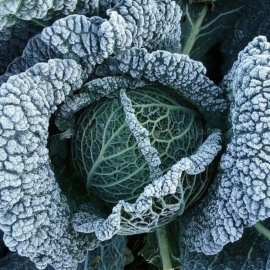
«Verona Purple» - Organic Cabbage Seeds
1.14 €
Verona Purple forms large, firm and dense, slightly flattened, green-purple heads and these heads are surrounded by green-purple, slightly coarse and curled leaves. The purple colouring intensifys when the temperatures drop at night.
-
Organic Cabbage «Verona Purple»
Verona Purple forms large, firm and dense, slightly flattened, green-purple heads and these heads are surrounded by green-purple, slightly coarse and curled leaves.
The purple colouring intensifys when the temperatures drop at night. This late variety can overwinter in the soil till it's time to harvest. The heads can weight up to 4 kilo each. This very deliciously flavoured savoy cabbage variety can be kept fresh for about 1 month after harvesting in a cool and dark place.
Verona Purple can be harvested after about 90 days after transplanting. Use this variety cooked in mashed potato stews, ovendishes and other dishes with cabbage. The leaves can be used as wrap for minced meat or other dishes and cooked or prepared in a oven.
How to Grow
Sow seeds indoors 6 to 8 weeks before average last spring frost. Keep soil warm (about 75 F) until germination. Then keep plants around 60 F. Provide direct sun so plants don't get leggy. When plants are 4 to 6 weeks old, transplants into garden 12 to 24" apart, in rows 18 to 34" apart. Use closer spacing for smaller, early varieties, wider spacing for larger, late-season varieties. Can be direct seeded as soon as you can work the soil. Will germinate at soil temps as low as 40 F. Plant ¼ to ½ inch deep, about 3 inches apart.
Thin to final spacing. Direct seed in summer for fall crop, or start transplants in late May and transplant in late June or early July. Plants have shallow root systems. Avoid even shallow cultivation. Mulch to protect roots, reduce weed competition and conserve moisture. Use floating row cover to protect crop from early pests. When heads are mature, they are prone to splitting in response to any stress or a rain following a dry period.
Avoid splitting by choosing varieties that resist splitting, spacing plants close together (8 to 12 inches for early varieties, 12 to 16 inches for later varieties), using shovel to sever roots on one side about 6 inches from the plant, or twisting plants after heads have firmed to break some of the roots.
To help reduce disease, do not plant cabbage or other cole crops in the same location more than once every three or four years. When cabbages are 4 to 5 inches tall, thin or transplant to stand 18 to 24 inches apart. Apply a thick layer of mulch to retain moisture. Water plants during the summer if rainfall is less than 1 inch per week. Contact your local county extension office for controls of common cabbage pests such as aphids, root maggots, cabbage-worms, and cabbage loopers.
